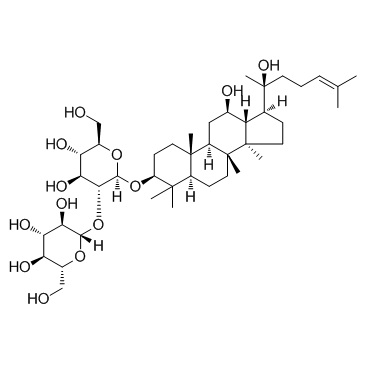Ginsenoside Rg3

Ginsenoside Rg3 structure
|
Common Name | Ginsenoside Rg3 | ||
|---|---|---|---|---|
| CAS Number | 14197-60-5 | Molecular Weight | 785.013 | |
| Density | 1.3±0.1 g/cm3 | Boiling Point | 885.0±65.0 °C at 760 mmHg | |
| Molecular Formula | C42H72O13 | Melting Point | 315-318°C | |
| MSDS | Chinese USA | Flash Point | 489.0±34.3 °C | |
| Symbol |

GHS07 |
Signal Word | Warning | |
|
Characterization of Panax ginseng UDP-Glycosyltransferases Catalyzing Protopanaxatriol and Biosyntheses of Bioactive Ginsenosides F1 and Rh1 in Metabolically Engineered Yeasts.
Mol. Plant 8 , 1412-24, (2015) Ginsenosides, the main pharmacologically active natural compounds in ginseng (Panax ginseng), are mostly the glycosylated products of protopanaxadiol (PPD) and protopanaxatriol (PPT). No uridine diphosphate glycosyltransferase (UGT), which catalyzes PPT to pr... |
|
|
Comparative study on intestinal metabolism and absorption in vivo of ginsenosides in sulphur-fumigated and non-fumigated ginseng by ultra performance liquid chromatography quadruple time-of-flight mass spectrometry based chemical profiling approach.
Drug Test. Anal. 7(4) , 320-30, (2015) Our previous study indicated that sulphur-fumigation of ginseng in post-harvest handling processes could induce chemical transformation of ginsenosides to generate multiple ginsenoside sulphur derivatives. In this study, the influence of sulphur-fumigation on... |
|
|
Red ginseng extract promotes the hair growth in cultured human hair follicles.
J. Med. Food 18(3) , 354-62, (2015) Ginseng has been shown to promote hair growth in several recent studies. However, its effects on human hair follicles and its mechanisms of action have not been sufficiently elucidated. This study aimed to investigate the hair growth-promoting effects of red ... |
|
|
Novel roles of ginsenoside Rg3 in apoptosis through downregulation of epidermal growth factor receptor
Chem. Biol. Interact. 233 , 25-34, (2015) • Ginsenoside Rg3 induces apoptosis with strong cytotoxicity. • Ginsenoside Rg3 modulates EGFR internalization. • Ginsenoside Rg3 induces EGFR degradation after internalization. • Ginsenoside Rg3 inhibits tumor growth in LLC-bearing C57BL/6 mice. |
|
|
Anti-breast cancer activity of Fine Black ginseng (Panax ginseng Meyer) and ginsenoside Rg5.
J. Ginseng. Res. 39 , 125-34, (2015) Black ginseng (Ginseng Radix nigra, BG) refers to the ginseng steamed for nine times and fine roots (hairy roots) of that is called fine black ginseng (FBG). It is known that the content of saponin of FBG is higher than that of BG. Therefore, in this study, w... |
|
|
Ginsenoside fractions regulate the action of monocytes and their differentiation into dendritic cells.
J. Ginseng. Res. 39(1) , 29-37, (2014) Panax ginseng (i.e., ginseng) root is extensively used in traditional oriental medicine. It is a modern pharmaceutical reagent for preventing various human diseases such as cancer. Ginsenosides-the major active components of ginseng-exhibit immunomodulatory e... |
|
|
Selected ginsenosides of the protopanaxdiol series are novel positive allosteric modulators of P2X7 receptors.
Br. J. Pharmacol. 172 , 3326-40, (2015) The P2X7 receptor is an ATP-gated ion channel predominantly expressed in immune cells and plays a key role in inflammatory processes. Ginseng is a well-known Chinese herb with both pro- and anti-inflammatory properties and many of its actions have been ascrib... |
|
|
American ginseng significantly reduced the progression of high-fat-diet-enhanced colon carcinogenesis in ApcMin/+mice
J. Ginseng. Res. 39 , 230-7, (2015) Background Colorectal cancer (CRC) is a leading cause of death worldwide. Chronic gut inflammation is recognized as a risk factor for tumor development, including CRC. American ginseng is a very commonly used ginseng species in the West. |
|
|
Pharmacokinetics, bioavailability, and metabolism of Notoginsenoside Fc in rats by liquid chromatography/electrospray ionization tandem mass spectrometry.
J. Pharm. Biomed. Anal. 109 , 150-7, (2015) Notoginsenoside Fc (NGFc) is a protopanaxadiol-type (PPD-type) saponin from Panax notoginseng, which has perfect anti-platelet aggregatory effect. However, its pharmacokinetics and metabolism in vivo remain unknown. In this study, a simple and sensitive liqui... |
|
|
Ginsenoside Rb1 inhibits fibrillation and toxicity of alpha-synuclein and disaggregates preformed fibrils.
Neurobiol. Dis. 74 , 89-101, (2015) Compelling evidence indicates that α-synuclein (α-syn) aggregation plays a central role in the pathogenesis of Parkinson's disease (PD) and other synucleinopathies. Identification of compounds that inhibit or reverse the aggregation process may thus represent... |